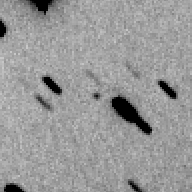The ZTF Survey scores the asteroid with the smallest aphelion distance
The ZTF Survey scores the asteroid with the smallest aphelion distance

neo admin

2020 AV2 observed from the Abastumani observatory in Georgia on 6 January 2020, in the context of our collaboration with the ISON network. At the time of the observation, the asteroid was located just 20° over the local horizon, at an elongation of 39° from the Sun.
Credit: ISON Abastumani (Kharadze Abastumani Astrophysical Observatory, Ilya State University)
The year has just started, and we already have a very interesting discovery of a new and so far unique asteroid.
The Zwicky Transient Facility (ZTF), a survey program currently operating the Samuel Oschin Telescope at the Palomar Observatory, has been dedicating some time to survey observations at very low solar elongations. These observations are capable of finding objects with orbits located entirely within the orbit of the Earth, the so-called Atira objects, or IEOs (Interior-Earth Objects). ZTF had already found quite a few of them last year, including 2019 LF6, the asteroid with the shortest known orbital period. So far, only about 20 are known, showing how difficult it is to discover them.
On 4 January 2020 they were observing an area at less than 40° of elongation from the Sun, when they discovered a new object that looked like a promising Atira candidate. Subsequent observations showed that the object was even more interesting: with an aphelion at just 0.654 au, the object's orbit is entirely contained within the orbit of planet Venus, making it the first known representative of the so-called "Vatira" class, the Venusian equivalent of Earth's Atiras.
The object is now designated 2020 AV2. It has an orbital period of 151 days, almost identical to 2019 LF6, but its lower eccentricity of just 0.178 makes it the natural object with the smallest known aphelion in our Solar System (except for planet Mercury).
